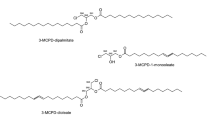Abstract
(R)-(+)-Pulegone is a major monoterpene constituent of pennyroyal oil, a mint oil obtained from the leaves of plants Mentha pulegiwn or Hedeoma pulegoides (1). Pennyroyal oil is widely used as a fragrance and flavoring agent (2), and has been used, based on folklore, as a herbal medicine to control menses and terminate pregnancy (3). The ingestion of large quantities of the oil has been associated with toxic effects (4–8), and hepatotoxicity observed in humans has been modeled in mice (9, 10) and rats (11, 12).
Access this chapter
Tax calculation will be finalised at checkout
Purchases are for personal use only
Preview
Unable to display preview. Download preview PDF.
Similar content being viewed by others
References
F. Grundschober, Literature review of pulegone, Perfum. Flavor. 4:15 (1979).
R. A. Hall and B. L. Oser, Recent progress in the consideration of flavoring ingredients under the food additives amendment III GRAS substances, Food Technol., 19:253 (1965).
M. N. Gleason, R. E. Gosselin, H. C. Hodge, and R. P. Smith, “Clinical Toxicology of Commercial Products,” 3rd ed., Williams and Wilkins, Co., Baltimore, p. 109. (1969).
J. M. Watt and M. G. Breyer-Brandwijk, “The Medicinal and Poisonous Plants of Southern and Eastern Africa,” 2nd ed., E. and S. Livingston, Ltd., London, p. 523 (1962).
W. B. Vallance, Pennyroyal oil poisoning: a fatal case, Lancet, ii, 850 (1955).
P. Gunby, Plant known for centuries still causes problems today, J. Am. Med. Assn.241:2246 (1979).
J. B. Sullivan, B. H. Rumack, H. Thomas, R. G. Peterson, and P. Brysch,Pennyroyal oil poisoning and hepatotoxicity, J. Am. Med. Assn., 242:2873 (1979).
J. Gold and W. Cates, Herbal abortifacients, J. Am. Med. Assn. 243:1365 (1980).
W. P. Gordon, A. J. Forte, R. J. McMurtry, J. Gal, and S. D. Nelson, Hepatotoxicity and pulmonary toxicity of pennyroyal oil and its constituent terpenes in the mouse, Toxicol. Appl. Pharmacol., 65:413 (1982).
T. Mizutani, H. Nomura, K. Nakanishi, and S. Fujita, Effects of drug metabolism modifiers on pulegone-induced hepatotoxicity in mice, Res. Commun. Chem. Pathol. Pharmacol., 58:75 (1987).
D. Thomassen, J. T. Slattery, and S. D. Nelson, Contribution of menthofuran to the hepatotoxicity of pulegone: Assessment based on matched area under the curve and on matched time course, J. Pharmacol. Exp. Ther., 224:825 (1988).
B. Moorthy, P. Madyastha, and K. M. Madyastha, Hepatotoxicity of pulegone in rats: its effects on microsomal enzymes, in vitro. Toxicol. 55:327 (1989).
S. D. Nelson and W. P. Gordon, Mammalian drug metabolism, J. of Nat. Prod.,46:71 (1983).
W. P. Gordon, A. C. Huitric, C. L. Seth, R. H. McClanahan, and S. D. Nelson, The metabolism of the abortifacient terpene, (R)-(+)-pulegone, to a proximate toxin, menthofuran, Drug Metab. Dispos. 15:589 (1987).
B. Moorthy, P. Madyastha, and K. M. Madyastha, Metabolism of a monoterpene ketone, (R)-(+)-pulegone, a hepatotoxin in rat, Xenobiotica. 19:217 (1989).
R. H. McClanahan, A. C. Huitric, P. G. Pearson, J. C. Desper, and S. D. Nelson,Evidence for a cytochrome P-450 catalyzed allylic rearrangement with double bond topomerization. J. Amer. Chem. Soc., 110:1979 (1988).
R. H. McClanahan, D. Thomassen, J. T. Slattery, and S. D. Nelson, Metabolic activation of (R)-(+)-pulegone to a reactive enonal that covalently binds to mouse liver proteins, Chem. Res. Toxicol., 2:349 (1989).
T. M. Feely and M. K. Hargreaves, Circular dichroism studies. The pulegone epoxides, J. Chem. Soc. (C), p. 1745 (1970).
O. Nakanishi, M. Fujitani, I. Ichimoto, and H. Ueda, An improved process for the synthesis of piperitenone from mesityloxide and methyl vinyl ketone, Agric. Biol. Chem., 44:1667 (1980).
J. A. Hirsch and A. J. Szur, The hydrolysis of α,α’-dimethoxydihydrofurans, L Heter. Chem., 9:523 (1972).
K. M. Madyastha and B. Moorthy, Pulegone mediated hepatotoxicity: Evidence for covalent binding of (R)-(+)-[14C] pulegone to microsomal proteins in vitro ,Chem Biol. Interact., 72:325 (1989).
D. Thomassen, R. H. McClanahan, N. Knebel, J. T. Slattery, and S. D. Nelson,submitted.
K. M. Madyastha and C. P. Raj, Biotransformation of R-(+)-pulegone and menthofuran in vitro: chemical basis for toxicity, Biochem. Biophys. Res. CommiπL, 173:1086 (1990).
D. Thomassen, J. T. Slattery, and S. D. Nelson, Menthofuran-dependent and independent aspects of pulegone hepatotoxicity: Roles of glutathione, J. Pharmacol. Exp. Ther. 253:567 (1990).
W. P. Gordon, Studies on the mechanism of toxicity of pennyroyal oil, Ph.D.Dissertation. University of Washington Press, Seattle, WA (1982).
D. Thomassen, P. G. Pearson, J. T. Slattery, and S. D. Nelson, Partial characterization of biliary metabolites of pulegone by tandem mass spectrometry: detection of glucuronide, glutathione, and glutathionyl glucuronide conjugates, Drug Metab. Dispos., in press.
Author information
Authors and Affiliations
Editor information
Editors and Affiliations
Rights and permissions
Copyright information
© 1992 Springer Science+Business Media New York
About this chapter
Cite this chapter
Nelson, S.D., McClanahan, R.H., Knebel, N., Thomassen, D., Gordon, W.P., Oishi, S. (1992). The Metabolism of (R)-(+)-Pulegone, a Toxic Monoterpene. In: Petroski, R.J., McCormick, S.P. (eds) Secondary-Metabolite Biosynthesis and Metabolism. Environmental Science Research, vol 44. Springer, Boston, MA. https://doi.org/10.1007/978-1-4615-3012-1_19
Download citation
DOI: https://doi.org/10.1007/978-1-4615-3012-1_19
Publisher Name: Springer, Boston, MA
Print ISBN: 978-1-4613-6312-5
Online ISBN: 978-1-4615-3012-1
eBook Packages: Springer Book Archive




